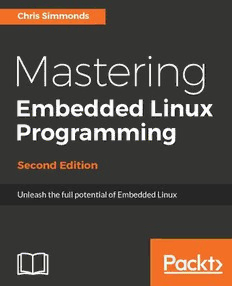
Mastering Embedded Linux Programming PDF
02017·3.612 MB·English
Most books are stored in the elastic cloud where traffic is expensive. For this reason, we have a limit on daily download.
Preview Mastering Embedded Linux Programming
Description:
Cover -- Copyright -- Credits -- About the Author -- About the Reviewers -- www.PacktPub.com -- Customer Feedback -- Table of Contents -- Preface -- Chapter 1: Starting Out -- Selecting the right operating system -- The players -- Project life cycle -- The four elements of embedded Linux -- Open source -- Licenses -- Hardware for embedded Linux -- Hardware used in this book -- The BeagleBone Black -- QEMU -- Software used in this book -- Summary -- Chapter 2: Learning About Toolchains -- Introducing toolchains -- Types of toolchains -- CPU architectures -- Choosing the C library -- Finding a toolchain -- Building a toolchain using crosstool-NG -- Installing crosstool-NG -- Building a toolchain for BeagleBone Black -- Building a toolchain for QEMU -- Anatomy of a toolchain -- Finding out about your cross compiler -- The sysroot, library, and header files -- Other tools in the toolchain -- Looking at the components of the C library -- Linking with libraries -- static and dynamic linking -- Static libraries -- Shared libraries -- Understanding shared library version numbers -- The art of cross compiling -- Simple makefiles -- Autotools -- An example: SQLite -- Package configuration -- Problems with cross compiling -- Summary -- Chapter 3: All About Bootloaders -- What does a bootloader do? -- The boot sequence -- Phase 1 -- ROM code -- Phase 2 -- secondary program loader -- Phase 3 -- TPL -- Booting with UEFI firmware -- Moving from bootloader to kernel -- Introducing device trees -- Device tree basics -- The reg property -- Labels and interrupts -- Device tree include files -- Compiling a device tree -- Choosing a bootloader -- U-Boot -- Building U-Boot -- Installing U-Boot -- Using U-Boot -- Environment variables -- Boot image format -- Loading images -- Booting Linux -- Automating the boot with U-Boot scripts -- Porting U-Boot to a new board.;Master the techniques needed to build great, efficient embedded devices on LinuxAbout This Book* Discover how to build and configure reliable embedded Linux devices* This book has been updated to include Linux 4.9 and Yocto Project 2.2 (Morty)* This comprehensive guide covers the remote update of devices in the field and power managementWho This Book Is ForIf you are an engineer who wishes to understand and use Linux in embedded devices, this book is for you. It is also for Linux developers and system programmers who are familiar with embedded systems and want to learn and program the best in class devices. It is appropriate for students studying embedded techniques, for developers implementing embedded Linux devices, and engineers supporting existing Linux devices. What You Will Learn* Evaluate the Board Support Packages offered by most manufacturers of a system on chip or embedded module* Use Buildroot and the Yocto Project to create embedded Linux systems quickly and efficiently* Update IoT devices in the field without compromising security* Reduce the power budget of devices to make batteries last longer* Interact with the hardware without having to write kernel device drivers* Debug devices remotely using GDB, and see how to measure the performance of the systems using powerful tools such as perk, ftrace, and valgrind* Find out how to configure Linux as a real-time operating systemIn DetailEmbedded Linux runs many of the devices we use every day, from smart TVs to WiFi routers, test equipment to industrial controllers - all of them have Linux at their heart. Linux is a core technology in the implementation of the inter-connected world of the Internet of Things. The comprehensive guide shows you the technologies and techniques required to build Linux into embedded systems. You will begin by learning about the fundamental elements that underpin all embedded Linux projects: the toolchain, the bootloader, the kernel, and the root filesystem. You'll see how to create each of these elements from scratch, and how to automate the process using Buildroot and the Yocto Project. Moving on, you'll find out how to implement an effective storage strategy for flash memory chips, and how to install updates to the device remotely once it is deployed. You'll also get to know the key aspects of writing code for embedded Linux, such as how to access hardware from applications, the implications of writing multi-threaded code, and techniques to manage memory in an efficient way. The final chapters show you how to debug your code, both in applications and in the Linux kernel, and how to profile the system so that you can look out for performance bottlenecks. By the end of the book, you will have a complete overview of the steps required to create a successful embedded Linux system. Style and approachThis book is an easy-to-follow and pragmatic guide with in-depth analysis of the implementation of embedded devices. It follows the life cycle of a project from inception through to completion, at each stage giving both the theory that underlies the topic and practical step-by-step walkthroughs of an example implementation.
See more
The list of books you might like
Most books are stored in the elastic cloud where traffic is expensive. For this reason, we have a limit on daily download.
